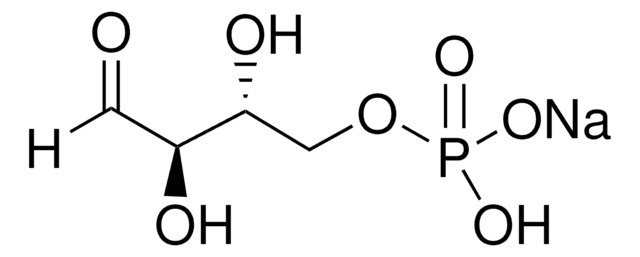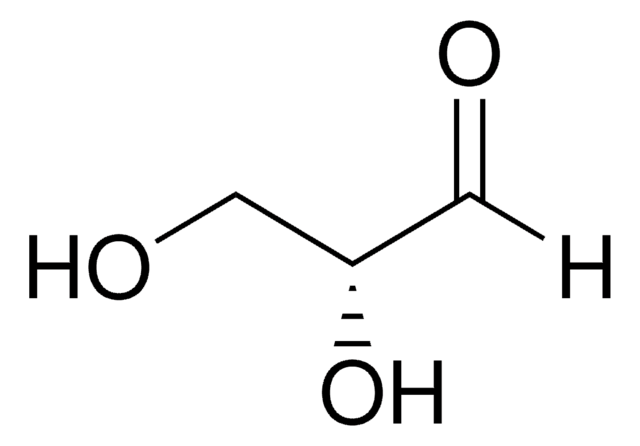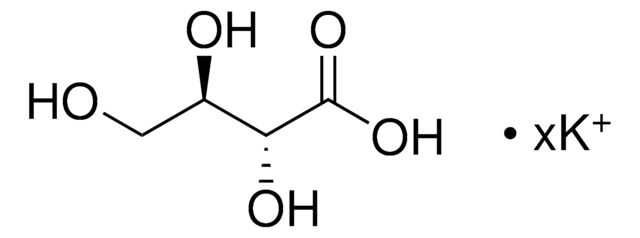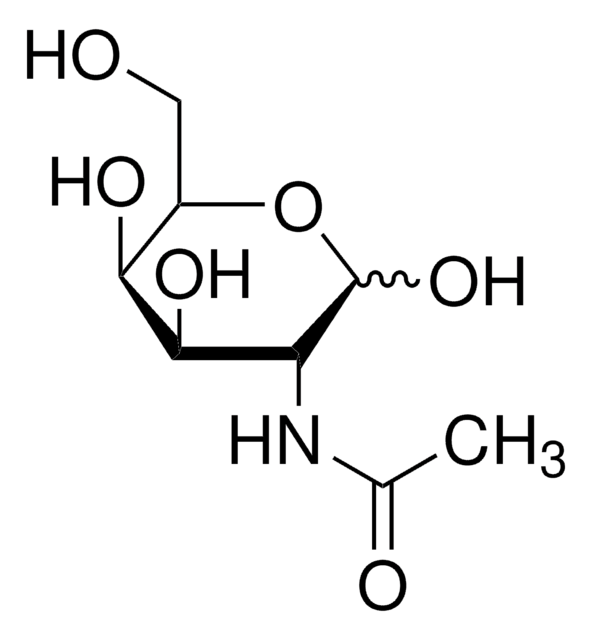E7625
D-(−)-Erythrose
≥75% (TLC), syrup
Sinonimo/i:
(2R,3R)-2,3,4-trihydroxybutanal
Autenticatiper visualizzare i prezzi riservati alla tua organizzazione & contrattuali
About This Item
Formula empirica (notazione di Hill):
C4H8O4
Numero CAS:
Peso molecolare:
120.10
Beilstein:
1721698
Numero CE:
Numero MDL:
Codice UNSPSC:
12352201
ID PubChem:
NACRES:
NA.25
Prodotti consigliati
Livello qualitativo
Saggio
≥75% (TLC)
Stato
syrup
Colore
colorless to very dark yellow
Temperatura di conservazione
2-8°C
Stringa SMILE
[H]C(=O)[C@H](O)[C@H](O)CO
InChI
1S/C4H8O4/c5-1-3(7)4(8)2-6/h1,3-4,6-8H,2H2/t3-,4+/m0/s1
YTBSYETUWUMLBZ-IUYQGCFVSA-N
Cerchi prodotti simili? Visita Guida al confronto tra prodotti
Applicazioni
D-(-)-Erythrose, the D enantiomer of the aldose aldehyde erythrose, may be used as a reference compound in sugar metabolism analysis. D-(-)-Erythrose may be used to help identify and characterize erythrose reductase(s). D-Erythrose may be used to study the mechanisms of mutarotation in monosugars. D-Erythrose may be used to study the mechanisms of organic microspherule formation and Maillard (glycation) reactions.
Altre note
To gain a comprehensive understanding of our extensive range of Monosaccharides for your research, we encourage you to visit our Carbohydrates Category page.
Codice della classe di stoccaggio
10 - Combustible liquids
Classe di pericolosità dell'acqua (WGK)
WGK 3
Punto d’infiammabilità (°F)
Not applicable
Punto d’infiammabilità (°C)
Not applicable
Dispositivi di protezione individuale
Eyeshields, Gloves
Scegli una delle versioni più recenti:
Possiedi già questo prodotto?
I documenti relativi ai prodotti acquistati recentemente sono disponibili nell’Archivio dei documenti.
Birgit Jovanović et al.
AMB Express, 3(1), 43-43 (2013-08-09)
Proteins with putative erythrose reductase activity have been identified in the filamentous fungi Trichoderma reesei, Aspergillus niger, and Fusarium graminearum by in silico analysis. The proteins found in T. reesei and A. niger had earlier been characterized as glycerol dehydrogenase
Tomasz Janek et al.
Microbial cell factories, 16(1), 118-118 (2017-07-12)
Erythritol is a natural sweetener that is used in the food industry. It is produced as an osmoprotectant by bacteria and yeast. Due to its chemical properties, it does not change the insulin level in the blood, and therefore it
Julia Schörghuber et al.
Journal of biomolecular NMR, 71(3), 129-140 (2018-05-29)
In recent years, we developed a toolbox of heavy isotope containing compounds, which serve as metabolic amino acid precursors in the E. coli-based overexpression of aromatic residue labeled proteins. Our labeling techniques show excellent results both in terms of selectivity
Arthur L Weber
Origins of life and evolution of the biosphere : the journal of the International Society for the Study of the Origin of Life, 35(6), 523-536 (2005-10-29)
Reaction of small sugars of less than four carbons with ammonia in water yielded organic microspherules generally less than ten microns in size. The time course of microspherule growth was examined for the D-erythrose-ammonia reaction that yielded microspherules attached to
Danielle Rand et al.
Origins of life and evolution of the biosphere : the journal of the International Society for the Study of the Origin of Life, 41(1), 17-22 (2010-06-22)
Reactions of short sugars under mild, plausibly prebiotic conditions yield organic microspherules that may have played a role in prebiotic chemistry as primitive reaction vessels. It has been widely thought that nitrogen chemistry, in particular Amadori rearrangement, is central to
Il team dei nostri ricercatori vanta grande esperienza in tutte le aree della ricerca quali Life Science, scienza dei materiali, sintesi chimica, cromatografia, discipline analitiche, ecc..
Contatta l'Assistenza Tecnica.








